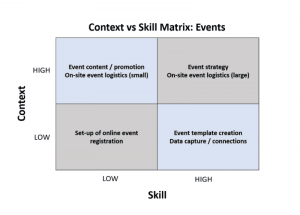Operational maturity is a key indicator of marketing effectiveness. Here are some solid metrics to track it.

Let’s start with the basics.
The term “operational maturity” may be relatively new to some marketers, but the concept is well established. It ranks how effectively an organization executes and manages the way it does business, from internal strategies, to resources, to the structures that deliver products or services.
The essentials of operational maturity involve management practices, process improvement, technology and how it’s used, and staff capabilities, including existing skill sets, training opportunities, and identifying personnel or skill gaps.
To achieve and accelerate operational maturity, operational metrics come into play. These are quantitative evaluations that allow organizations to accurately follow the steps made toward specific objectives. They also provide perspectives on achievements within the organization at macro and micro levels. These metrics eliminate guesswork because they provide an informed view of current state and past performance, enabling organizations to make solid decisions.
The goal for organizations, then, is to cultivate a sustained, proactive and informed process for gathering and using operational data — operational metrics maturity — to achieve optimal performance and results.
Understanding the spectrum of operational maturity
The first thing to understand is that one organization’s operational maturity is not going to be the same as another’s. Size of department, tenure of team, access to technology and budget are just some of the factors that can influence maturity.
Achieving operational maturity within a marketing department of 50 associates with a $ 20 million budget will look completely different than a four person department with a $ 1 million budget. Although it’s every marketing leader’s goal to reach optimal operational maturity, it’s imperative to realize that falling short of that does not mean you’re failing.
Begin by evaluating your strategic objectives through the lens of data, considering the following questions:
1. What type of data does your organization gather? For example:
- Strategic performance measures.
- Process performance measures.
- In-market performance measures.
- Effectiveness/performance of assets.
- Time tracking.
- Customer interaction data
2. How is the data gathered?
3. Do you regularly take action on this data?
4. How frequently are you able to access updated data?
5. Do you have a data visualization and reporting strategy for performance metrics?
6. Does your team have access to customer sentiment data that captures the emotions, opinions, attitudes and overall sentiment of customers toward a product, service or brand?
7. What is your typical planning horizon for marketing programs/campaigns?
8. Are your technology tools integrated?
Discovering your KPIs
You’ve determined your strategic direction — now what? The next step is to set up new key performance indicators or reevaluate your existing performance indicators. Consider these categories of performance indicators as you decide what measures matter most:
- Strategic performance indicators show where the organization is achieving outcomes.
- Operational performance indicators show inputs, process and outputs.
- In-market performance indicators outline how the tactics you’ve used have performed.
This isn’t an exhaustive list, and there are other metrics that will contribute to the ways you can monitor your organization’s progress toward meeting strategic objectives. Based on what your organization’s objectives are, you can customize your measurement categories and track the metrics accordingly.
Defining ‘optimal performance and results’
With thousands of metrics and KPIs that can be analyzed within a marketing department it can be very challenging for leaders to determine which ones to focus on. As a revenue enablement engine, it’s critical to align marketing KPIs with overall strategic firm initiatives. This is the path to follow to achieve your company’s objectives and ensure you’re fulfilling your mission and value proposition.
A company goal to grow revenue by 10% might result in different marketing KPIs than a company goal to improve Net Promoter Score (NPS) by 5%.
Less is more
When choosing which KPIs to focus on, remember that less is more. Identify the metrics that move the needle and directly influence your strategic goal. For instance, when analyzing content marketing data, you might need to look at page views, unique visitors, time on page, scroll depth, backlinks, bounce rate, keyword rankings, click-thru rate, conversion rate, pages per session, etc.
Avoid paralysis by analysis by choosing the top two “needle-moving” metrics out of the laundry list of dozens of metrics. This will lead to more actionable data and provide clearer insights for immediate action.
Your secret weapon: Innovation and creativity metrics
Innovation and creativity metrics are crucial in a marketing organization as they help assess and drive the effectiveness, impact and originality of marketing efforts. They are essential for enhancing customer engagement, driving competitive advantage and improving marketing effectiveness. Consider selecting one or two metrics from the following list:
- Number of new ideas generated.
- Number of new ideas implemented.
- Innovation rate.
- Time to market for new ideas.
By systematically tracking and analyzing these metrics, the marketing organization can better understand the impact of its creative efforts, identify successful strategies, and continually enhance its approach to innovation. This leads to more effective marketing campaigns, stronger brand differentiation, and ultimately, improved business performance.
Moving up and next steps
As you make the shift toward moving up with operational maturity, prioritize using data as a starting point.
As you gather data that informs where your organization stands currently, you can evaluate your KPIs and related performance measures. From there, you can begin to establish targeted goals, making sure your processes harmonize with your objectives. As you implement a structure for reviewing and evaluating performance on a regular basis, you can spark creativity and ongoing improvements.
The post Moving up with marketing operational maturity appeared first on MarTech.
(5)
Report Post








